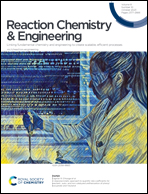A stepwise kinetic approach to quantify rate coefficients for reactant-, auto- and non-catalyzed urethanization of phenyl isocyanate and 1-butanol†
Abstract
Limited kinetic information is available on the formation of polyurethanes with ongoing ambiguity in the exact reaction mechanism, which is complicated by the less understood competition between non-catalyzed and molecule-assisted reactions such as catalysis by the alcohol, the isocyanate, and the carbamate. In the present work, focusing on urethane formation based on the monofunctional analogues 1-butanol and phenyl isocyanate in dichloromethane, a two-step kinetic approach is presented, which is capable of first determining rate coefficients and Arrhenius parameters as kinetically significant under diluted conditions, and then determining extra rate coefficients as relevant in a large excess of one of the reactants. Gas chromatography and UV-vis analysis have been applied to quantify (carbamate) product yields as a function of time under quasi-stoichiometric concentrations and with a large 1-butanol excess, and reaction-event driven kinetic Monte Carlo modeling is applied to tune the rate coefficient of each kinetically relevant reaction pathway. It is shown that butanol catalyzed and carbamate catalyzed reactions are the most activated, and the formation of a complex based on two 1-butanol molecules and 1 phenyl isocyanate molecule has a significant influence on the kinetics, specifically in the case of high initial alcohol concentrations. The kinetic interpretations are supported by reaction probability variations as well as sensitivity analyses. The present two-step kinetic approach opens the door to delivering more reliable rate coefficients on the elementary reaction level for polyurethane systems and showcases that even under conventional conditions, as relevant for at least solution polyurethane formation, unconventional complex-based mechanisms can be more active than we currently anticipate based on conventional kinetic laws.



 Please wait while we load your content...
Please wait while we load your content...